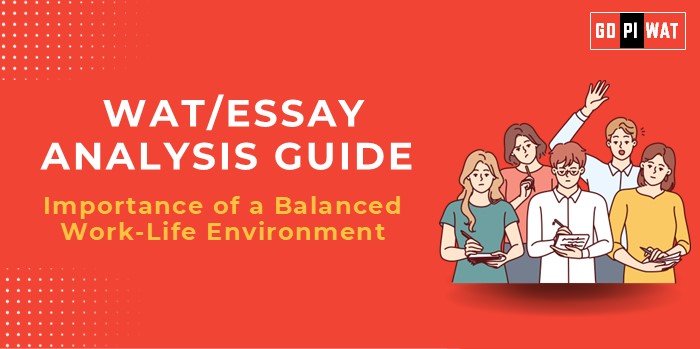📋 WAT/Essay Analysis Guide
🌐 Understanding the Importance of a Balanced Work-Life Environment
Balanced work-life is essential to sustainable business practices and individual well-being, with implications on productivity, mental health, and employee retention. Its importance has grown post-pandemic, reflecting a major theme in HR and management studies.
📝 Effective Planning and Writing
- ⏱️ Time Allocation:
- Planning: 5 minutes
- Writing: 20 minutes
- Review: 5 minutes
- 📚 Preparation Tips: Gather key statistics, understand stakeholder roles, and consider both benefits and challenges to form a well-rounded perspective.
💡 Introduction Techniques for Essays
- 🔍 Contrast Approach: “While digital technology enables flexible work, it can blur work-life boundaries, highlighting the need for structured policies.”
- 🔧 Solution-Based Approach: “A balanced work-life environment is not just about policies but creating a culture that values both productivity and personal well-being.”
- 📜 Timeline Approach: “From 9-to-5 schedules to today’s flexible models, the concept of work-life balance has evolved with changing workplace expectations.”
📖 Structuring the Essay Body
- 🏆 Achievements:
- Highlight increased productivity, job satisfaction, and health benefits supported by data.
- ⚖️ Challenges with Comparative Analysis:
- Discuss boundary challenges, economic pressure for extended hours, and contrast with countries like Sweden that have implemented shorter workdays.
- 🚀 Future Outlook:
- Predict the future of balance in the workplace, including potential advancements in flexible scheduling and support for mental health.
🎯 Concluding Effectively
- ⚖️ Balanced Perspective: “Achieving work-life balance is an ongoing effort, one that requires commitment from organizations and individuals alike to foster well-being and productivity.”
- 🌍 Global Comparison: “As global examples show, prioritizing work-life balance can lead to healthier, more productive societies, making it an essential focus for organizations worldwide.”
📊 Analyzing Successes and Shortcomings
- 🏅 Key Achievements: Enhanced flexibility, increased job satisfaction, improved mental health.
- 🤔 Ongoing Challenges: Difficulty maintaining boundaries, resistance from industries with traditionally rigid structures.
- 🌍 Global Context: Scandinavian work-life models show the benefits of prioritizing balance over high-intensity work hours.
🔍 Recommendations for Sustainable Progress
- 📋 Flexible Policies: Encourage remote work and flexible hours.
- 💡 Mental Health Support: Provide access to mental health resources.
- 📚 Boundary Guidelines: Educate employees on setting work-life boundaries, even in remote settings.
📄 Sample Short Essays on Importance of a Balanced Work-Life Environment
- ⚖️ Balanced Perspective: “Work-life balance fosters productivity and well-being, essential for sustainable growth in any industry. By setting clear boundaries and supporting flexibility, companies can benefit both employees and their bottom line.”
- 🔧 Solution-Oriented: “Introducing flexible work policies can lead to higher job satisfaction and retention rates. While balance may vary by industry, it remains a core component of a productive workplace.”
- 🌍 Global Comparison: “Countries like Sweden show that reducing work hours can still yield high productivity, offering a model for achieving work-life balance in today’s fast-paced environment.”


